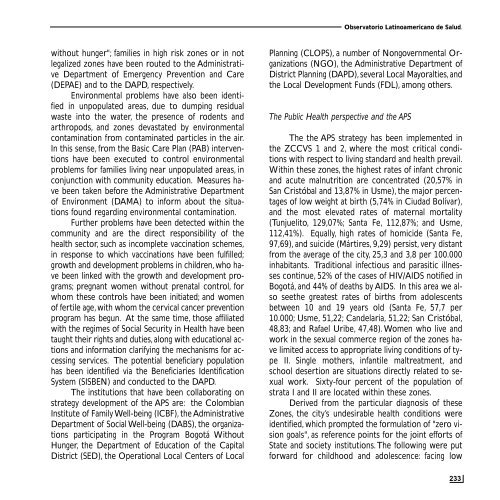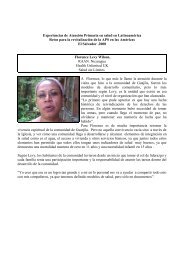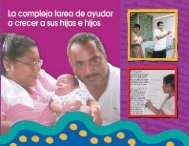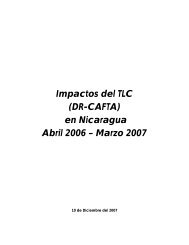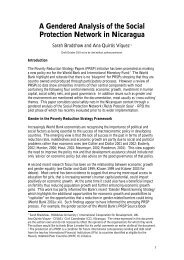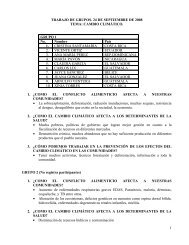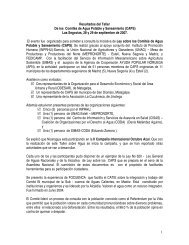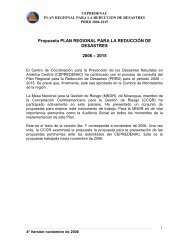Download - CISAS | Centro de Información y Servicios de AsesorÃa ...
Download - CISAS | Centro de Información y Servicios de AsesorÃa ...
Download - CISAS | Centro de Información y Servicios de AsesorÃa ...
You also want an ePaper? Increase the reach of your titles
YUMPU automatically turns print PDFs into web optimized ePapers that Google loves.
Observatorio Latinoamericano <strong>de</strong> Salud.without hunger"; families in high risk zones or in notlegalized zones have been routed to the AdministrativeDepartment of Emergency Prevention and Care(DEPAE) and to the DAPD, respectively.Environmental problems have also been i<strong>de</strong>ntifiedin unpopulated areas, due to dumping residualwaste into the water, the presence of ro<strong>de</strong>nts andarthropods, and zones <strong>de</strong>vastated by environmentalcontamination from contaminated particles in the air.In this sense, from the Basic Care Plan (PAB) interventionshave been executed to control environmentalproblems for families living near unpopulated areas, inconjunction with community education. Measures havebeen taken before the Administrative Departmentof Environment (DAMA) to inform about the situationsfound regarding environmental contamination.Further problems have been <strong>de</strong>tected within thecommunity and are the direct responsibility of thehealth sector, such as incomplete vaccination schemes,in response to which vaccinations have been fulfilled;growth and <strong>de</strong>velopment problems in children, who havebeen linked with the growth and <strong>de</strong>velopment programs;pregnant women without prenatal control, forwhom these controls have been initiated; and womenof fertile age, with whom the cervical cancer preventionprogram has begun. At the same time, those affiliatedwith the regimes of Social Security in Health have beentaught their rights and duties, along with educational actionsand information clarifying the mechanisms for accessingservices. The potential beneficiary populationhas been i<strong>de</strong>ntified via the Beneficiaries I<strong>de</strong>ntificationSystem (SISBEN) and conducted to the DAPD.The institutions that have been collaborating onstrategy <strong>de</strong>velopment of the APS are: the ColombianInstitute of Family Well-being (ICBF), the AdministrativeDepartment of Social Well-being (DABS), the organizationsparticipating in the Program Bogotá WithoutHunger, the Department of Education of the CapitalDistrict (SED), the Operational Local Centers of LocalPlanning (CLOPS), a number of Nongovernmental Organizations(NGO), the Administrative Department ofDistrict Planning (DAPD), several Local Mayoralties, andthe Local Development Funds (FDL), among others.The Public Health perspective and the APSThe the APS strategy has been implemented inthe ZCCVS 1 and 2, where the most critical conditionswith respect to living standard and health prevail.Within these zones, the highest rates of infant chronicand acute malnutrition are concentrated (20,57% inSan Cristóbal and 13,87% in Usme), the major percentagesof low weight at birth (5,74% in Ciudad Bolívar),and the most elevated rates of maternal mortality(Tunjuelito, 129,07%; Santa Fe, 112,87%; and Usme,112,41%). Equally, high rates of homici<strong>de</strong> (Santa Fe,97,69), and suici<strong>de</strong> (Mártires, 9,29) persist, very distantfrom the average of the city, 25,3 and 3,8 per 100.000inhabitants. Traditional infectious and parasitic illnessescontinue, 52% of the cases of HIV/AIDS notified inBogotá, and 44% of <strong>de</strong>aths by AIDS. In this area we alsoseethe greatest rates of births from adolescentsbetween 10 and 19 years old (Santa Fe, 57,7 per10.000; Usme, 51,22; Can<strong>de</strong>laria, 51,22; San Cristóbal,48,83; and Rafael Uribe, 47,48). Women who live andwork in the sexual commerce region of the zones havelimited access to appropriate living conditions of typeII. Single mothers, infantile maltreatment, andschool <strong>de</strong>sertion are situations directly related to sexualwork. Sixty-four percent of the population ofstrata I and II are located within these zones.Derived from the particular diagnosis of theseZones, the city’s un<strong>de</strong>sirable health conditions werei<strong>de</strong>ntified, which prompted the formulation of "zero visiongoals", as reference points for the joint efforts ofState and society institutions. The following were putforward for childhood and adolescence: facing low233


